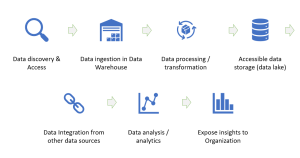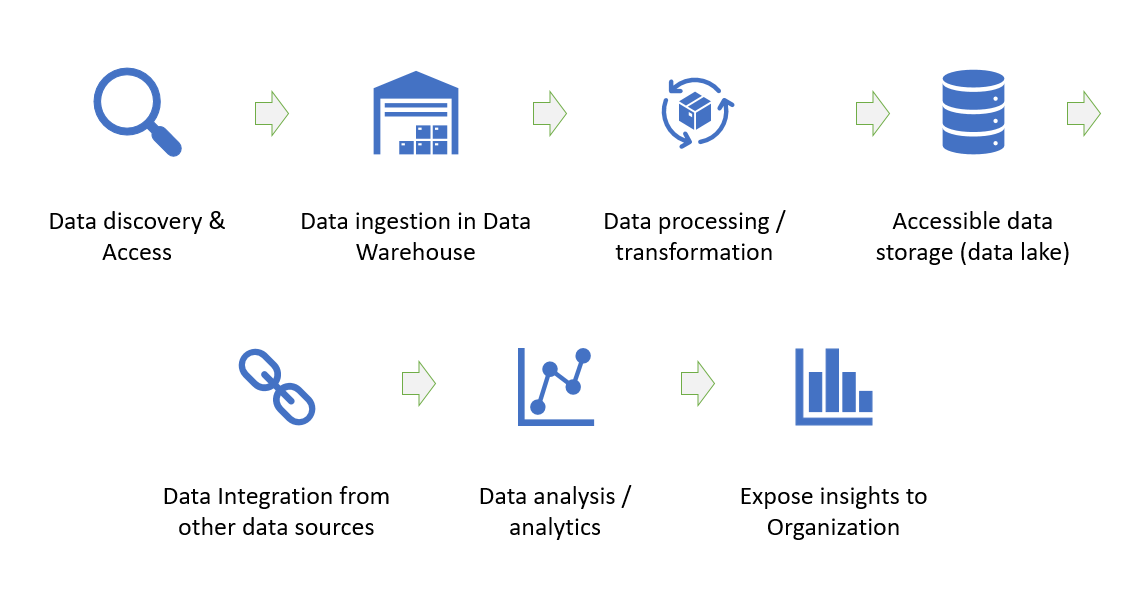
As organizations become increasingly data-driven, understanding the value of data is critical for success. The data value chain framework helps to identify and maximize the value of data by breaking it down into its components. In this post, we will explain what a data value chain is, why it’s important, and how to implement it.
Data Value Chain Framework: Key Stages
The data value chain (DVC) is a business model that helps organizations understand how to create, manage and utilize their data assets in order to realize maximum business value based on using them. It breaks down the various stages of an organization’s entire journey with its data into distinct phases—discovery, access / acquisition, storage, governance, analysis, monetization—and describes how each phase contributes to the overall success of the organization. The aim of this model is to help businesses maximize the potential of their data assets by understanding how they can be used at each step of the process.
It is the responsibility of data leaders including chief data officer (CDO) to ensure the data value chain is realized appropriately by business to maximize the value realization.
Here are the key stages of data-value chain

Here is the explanation for different stages as shown in the above diagram:
Data Discovery
Data discovery is a critical aspect of the data value chain because it enables organizations to identify and understand the data assets they possess and the data assets that they would need to collect from external world. The data assets would need to be aligned with the business needs which must be aligned with the current business objectives. This is must to avoid the scenario such as “boil the ocean”. Without proper data discovery, organizations may not be aware of all the data they have and the data that they need, leading to missed opportunities or inefficient decision-making.
Data discovery involves identifying where data is stored, what type of data it is, who owns the data, and how it is used. By performing thorough data discovery, organizations can ensure that their data assets are properly managed and leveraged to achieve business goals. Additionally, effective data discovery can help organizations improve their compliance with regulations such as GDPR or CCPA by ensuring that sensitive information is identified and protected appropriately.
Once the data is discovered, the next step is to get the data from different data sources with a goal to ingest the data in the data warehouse.
Data Ingestion in Data Warehouse
Gathering data from different data sources and ingesting the data in data warehouse is a critical stage in the data value chain. Data is collected from various sources, wrangled / prepared, and loaded into a centralized repository such as enterprise data warehouse (EDW). Ingesting data into a data warehouse involves transforming raw data into a structured format that can be easily queried and analyzed. Data ingestion into data warehouse is essential because it enables organizations to consolidate disparate data sources and create a unified view of their business operations. With all their data in one place, various different use cases can leverage data from EDW.
Data Processing / Transformation
Once the data is in EDW, data processing becomes the next important step in the data value chain. Data is processed and transformed into necessary format. As part of this stage, metadata is carefully chosen and precisely placed and added to ensure accuracy and further enable intelligent use of the data. Making sure the right level of refinement is applied is equally as critical not just for accuracy, but to ultimately ensure accuracy, throughput and a trustworthy pipeline of metadata.
Accessible Data Storage such as Data Lake
Now that the data has been collected and processed / transformed in the enterprise data warehouse (EDW), it’s time for this valuable information to find a place in a secure and easily accessible storage system such as a data lake. As part of the data life cycle succession of steps, this will allow us to easily access, share, and reuse the informational resources intertwined within.
Data integration from other sources
Once the data from EDW is moved into data lake, this data can be integrated with the data from other sources. This can be useful in creating useful insights as an output from different kinds of data analysis.
Data Analysis / Analytics
Once the data is available in the data lake, organizations are empowered to dive in and conduct comprehensive analyses of patterns and relationships detected within. From those findings, innovative data products and solutions can be generated that can lead to improved operational decisions and processes. With state-of-the art models for analyzing disparate datasets, opportunities for discovering actionable insights become realizable. By leveraging the power of data lakes consisting of structure and unstructured data, you can work on different analytics use cases using those related to AI / machine learning.
Exposing insights to organization
Finally, exposing the insights to others in the organization and encouraging the relevant decision-makers to execute on the intelligence helps realize the value from data. This is the final stage of data value chain.
Conclusion
In conclusion, understanding your organization’s data value chain is essential for making sure you get maximum benefit from your datasets. Start by setting up processes for discovering and collecting reliable data / information and processing data in data storages such as data ware houses / data lakes; maintaining data governance all through different stages; and deriving and exposing actionable insights to appropriate stakeholders. Data value chain, ideally, ends with data products which can help monetize the data set appropriately. Across the value chain, it is made sure that the data organization is up-to-date with any changes in technology such that one can continue making use of your invaluable data asset in a consistent and sustained manner! With a thorough understanding of the data value chain framework and proper implementation tactics , organizations can unlock real business value from their datasets!
- Mean Squared Error vs Cross Entropy Loss Function - April 28, 2024
- Cross Entropy Loss Explained with Python Examples - April 28, 2024
- Logistic Regression in Machine Learning: Python Example - April 26, 2024
Leave a Reply